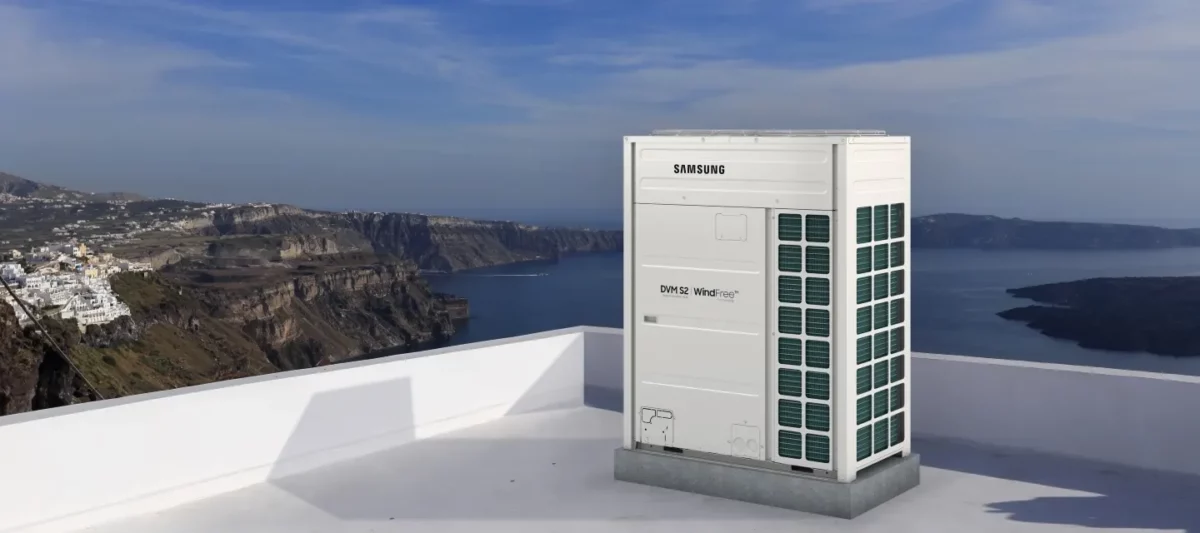Product Focus – Samsung Commercial HVAC System
You’re here to learn more about commercial HVAC systems, specifically the Samsung offerings. As you know, a commercial HVAC system is crucial in maintaining a comfortable and efficient indoor environment in a business. In this blog post, we will explore Samsung’s comprehensive range of HVAC solutions.
From energy-efficient technology to innovative designs, we’ll uncover what makes Samsung’s offerings stand out in the commercial HVAC market.
HVAC Systems for Commercial Buildings
Commercial HVAC System options are available as follows:
Packaged Rooftop Units (RTUs): These are all-in-one HVAC systems typically installed on the roof. They’re efficient and space-saving, making them ideal for commercial properties.
Variable Refrigerant Flow (VRF) Systems: VRF systems offer flexibility and zoning capabilities, allowing different building parts to be heated or cooled independently.
Chilled Water Systems: These systems use water to distribute cooling throughout a building, making them suitable for large commercial spaces.
Boiler Systems: Common for heating, boiler systems use hot water or steam to provide warmth in commercial buildings.
Split Systems: These consist of indoor and outdoor units, making them a good option for smaller commercial spaces.
Ductless Mini-Split Systems: These systems are similar to split systems but without ductwork. They’re efficient and allow for zoned cooling or heating.
Hybrid Systems: Combining traditional HVAC with renewable energy sources like solar or geothermal can be a sustainable choice for certain commercial buildings
Samsung offers a range of products for these commercial cooling categories, including their popular DVM and ERV ventilation ranges.
“As well as being the largest and most compact DVM system, the Samsung DVM S is also powerful and highly energy efficient. So, you can save costs and space while providing more reliable coverage across larger areas.” Samsung
The Features of the Samsung Commercial HVAC System
Samsung Commercial HVAC systems incorporate a range of features, and here are some of the more common ones you can expect:
Digital Inverter Compressors: These compressors adjust their speed and capacity to maintain precise temperature control, resulting in energy efficiency and consistent comfort.
Modular Configurations: Allowing flexibility in system layout and accommodating various commercial settings.
Zoning: Enabling different building parts to be heated or cooled independently, optimising comfort and energy use.
Smart Control Systems: Like remote monitoring, scheduling, and adjustment of HVAC settings.
The Benefits of a Samsung Commercial HVAC System
When selecting a Samsung Commercial HVAC system, the benefits are as follows:
Energy Efficiency: Samsung HVAC systems are known for their energy-saving features. They’ll help you reduce your business’ utility costs and environmental impact.
Innovative Technology: Samsung integrates cutting-edge technology like digital inverter compressors and smart controls to ensure precise temperature control and system efficiency.
Reliability: Samsung’s reputation for quality and reliability minimises downtime and maintenance costs.
Customisation: Many Samsung models offer modular designs and zoning capabilities, allowing tailored solutions for diverse commercial spaces.
Smart Controls: Samsung provides intuitive control systems, enabling users to monitor and manage their HVAC systems remotely, enhancing convenience and efficiency.
Green Solutions: Samsung is committed to sustainability, with eco-friendly refrigerants and systems that comply with environmental standards.
Quiet Operation: Samsung’s advanced designs offer a quieter operation for a more comfortable workspace for employees and customers.
Warranty and Support: Samsung typically offers excellent warranties and customer support – which is important when investing in your business’s growth.
These benefits make Samsung a compelling choice for businesses seeking efficient, reliable, and technologically advanced HVAC solutions for their commercial spaces.
The Disadvantages of a Samsung Commercial HVAC system
The advantages certainly outweigh the disadvantages, but they’re important to consider.
- Initial Cost: Samsung’s advanced technology, features, and marketing may come at a higher upfront cost.
- Complexity: The advanced technology in Samsung systems is complex and requires fitting by a qualified, experienced commercial HVAC system installation specialist.
- Availability
- Compatibility: Integrating Samsung HVAC systems with existing infrastructure may lead to complications in the project.
- Limited Model Range
- Maintenance Costs: Maintenance for technologically advanced systems, like Samsung’s, can be more comprehensive than straightforward HVAC solutions.
It’s crucial to carefully weigh these disadvantages against the advantages to determine if a Samsung commercial HVAC system aligns with your specific commercial needs and budget.
If you’re unsure, our HVAC experts can help you assess the needs of your business, along with your budget and create a solution that will work for your business.
Samsung has a comprehensive range of Commercial HVAC systems that we can certainly recommend. Whether they suit your business or you want to research a different manufacturer, we can help you find the right solution.
Find out more here, or give us a call 1300 306 847
Need More Help?
If you are still unsure of whether you need a domestic or commercial cooling unit, please get in touch with our team of expert technicians. We will run through your specific business requirements and help you decide which type of fridge or freezer is right for your needs.




